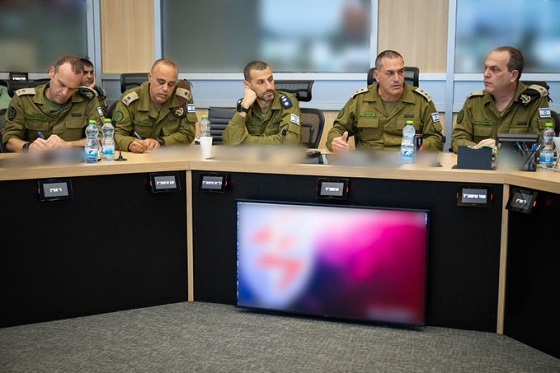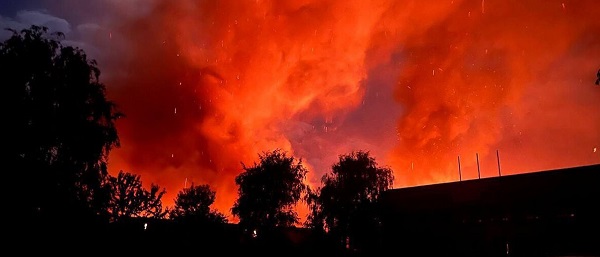conflict
Despite shaky start, ceasefire shows signs of holding

Chief of the General Staff LTG Eyal Zamir during a situational assessment following the beginning of the ceasefire with Iran
Quick Hit:
A fragile ceasefire between Israel and Iran appeared to hold Tuesday after early strikes from both sides threatened to unravel it. President Trump, who brokered the deal, criticized the violations and pushed both nations to stand down.
Key Details:
- Trump declared a “complete and total ceasefire” late Monday after Iran fired missiles at a U.S. base in Qatar in response to American strikes on its nuclear sites.
- Hours after the ceasefire was set to begin, Israel accused Iran of violating it by firing missiles into its territory—claims Tehran denied, even as explosions and air raid sirens rocked northern Israel.
- Trump publicly criticized both nations, stating “they don’t know what the f*** they’re doing,” and later confirmed that Israeli warplanes would turn back instead of launching a broader retaliation.
Diving Deeper:
Calm returned to parts of the Middle East Tuesday as a U.S.-brokered ceasefire between Israel and Iran began to settle in—though not without incident. For nearly two weeks, the region was on the brink of a broader war, ignited by Israeli strikes on Iranian nuclear and military targets and exacerbated by retaliatory attacks from Tehran.
President Donald Trump took credit for halting the hostilities. “ISRAEL is not going to attack Iran,” he wrote on Truth Social. “All planes will turn around and head home, while doing a friendly ‘Plane Wave’ to Iran. Nobody will be hurt, the Ceasefire is in effect!”
Despite the ceasefire’s official start early Tuesday morning, it nearly unraveled within hours. Israeli officials said Iran launched at least two missiles after the truce deadline, though they were intercepted before impact. Iran, meanwhile, denied any post-deadline strikes and blamed Israel for earlier attacks.
Speaking before leaving for a NATO summit, Trump said both sides had violated the agreement and did not hold back his frustration. “We basically have two countries that have been fighting so long and so hard that they don’t know what the f*** they’re doing,” he said, adding that he was “not happy with Israel.”
Still, the agreement held. Israeli Prime Minister Benjamin Netanyahu’s office said the country stood down from further attacks following a direct conversation with Trump. Israel claimed to have achieved its objectives, including weakening Iran’s nuclear and missile capabilities.
The conflict’s origin traces back to Israeli fears that Iran was nearing the threshold of building nuclear weapons, despite Tehran’s insistence that its program is for peaceful energy purposes. Over the weekend, the U.S. deepened its involvement by launching bunker-buster bombs on Iranian nuclear sites. Iran responded with a limited strike on a U.S. base in Qatar—an attack Washington said came with advance warning and caused no casualties.
Meanwhile, fallout from the war continues to spread. Israeli officials said at least 28 of their citizens have been killed and over 1,000 injured. Iranian casualty estimates are far higher, with nearly 1,000 reported dead, including hundreds of civilians and military personnel, according to the Human Rights Activists group.
Even as the ceasefire sets in, the risk of broader conflict remains. Pro-Iran militias in Iraq reportedly launched drone attacks on U.S. bases overnight, though they were intercepted without casualties. The U.S. has begun evacuating American citizens from Israel, and China—one of Iran’s few remaining oil buyers—has condemned the U.S. strikes, warning of a dangerous cycle of escalation.
Trump said he is not seeking regime change in Iran, walking back prior comments. “Regime change takes chaos and, ideally, we don’t want to see much chaos,” he told reporters aboard Air Force One.
Still, the situation remains volatile. The ceasefire, while welcomed, remains fragile—held together largely by Trump’s pressure campaign and the willingness of both sides to pause, if only momentarily, from what could have spiraled into an uncontrollable regional war.
Artificial Intelligence
AI Drone ‘Swarms’ Unleashed On Ukraine Battlefields, Marking New Era Of Warfare


From the Daily Caller News Foundation
Artificial intelligence-powered drones are making their first appearances on the battlefield in the Russia-Ukraine war as warfare creeps closer to full automation.
In bombardments on Russian targets in the past year, Ukrainian drones acting in concert were able to independently determine where to strike without human input.
It’s the first battlefield use of AI “swarm” technology in a real-world environment, a senior Ukrainian official and Swarmer, the company who makes the software, told the Wall Street Journal in a Tuesday report. While drones have increasingly defined modern battlefields, swarms until now had been confined to testing rather than combat.
“You set the target and the drones do the rest,” Swarmer Chief Executive Serhii Kupriienko told the WSJ. “They work together, they adapt.”
So far, the Swarmer technology has been used hundreds of times to target Russia assets, but was first used a year ago to lay mines on the front, the Ukrainian official told the WSJ. The software has been tested with up to 25 drones at once, but is usually utilized with only three.
Kupriienko told the WSJ that he was preparing to test up to 100 drones at once with the linking software.
A common arrangement used on the battlefield includes one reconnaissance drone to scout out the target and two explosive drones delivering the payload on target, the official told the WSJ.
While Western nations such as the U.S., France and the United Kingdom are also pursuing drone swarm technology, they have not deployed swarm technology on the battlefield the way Ukraine has, according to the WSJ. Currently, autonomous weapons are not regulated by any international authority or binding agreement, but ethical concerns around the technology has led many to call for increased regulation of weapons like the Swarmer system.
The Ukrainian Ministry of Foreign Affairs did not immediately respond to the Daily Caller News Foundation’s request for comment.
conflict
Trump Pentagon Reportedly Blocking Ukraine From Firing Western Missiles Deep Into Russia


From the Daily Caller News Foundation
The Department of Defense has spent months blocking the Ukrainian military from using American and British-made missiles to hit targets deep inside Russia, The Wall Street Journal reported Sunday, citing unnamed U.S. officials.
Undersecretary of Defense for Policy Eldridge Colby reportedly designed the procedure to review requests to carry out the long-range strikes with weapons that are either of U.S. origin or that require American intelligence or use components provided by the U.S., according to the WSJ. Secretary of Defense Pete Hegseth reportedly has the final say on whether Ukrainian forces can use the MGM-140 ATACMS (Army Tactical Missile System) to hit targets in Russia.
The reported blocks on missile strikes coincides with a Trump administration effort to broker a peace deal between Russia and Ukraine. A Pentagon spokesperson declined to comment further on the matter.
BREAKING: President Vladimir Putin reacts to B-2 Flyover pic.twitter.com/1mzVn7DxlW
— Jack Poso 🇺🇸 (@JackPosobiec) August 15, 2025
The Biden administration allowed Ukraine to carry out strikes with ATACMS in November, weeks after President Donald Trump won the 2024 election, the New York Times reported. Trump criticized the move during a December interview with Time magazine.
“It’s crazy what’s taking place. It’s crazy,” Trump said. “I disagree very vehemently with sending missiles hundreds of miles into Russia. Why are we doing that? We’re just escalating this war and making it worse. That should not have been allowed to be done.”
Trump and Russian President Vladimir Putin met in Alaska on Aug. 15 for a summit meeting during which Trump sought to secure a cease-fire in Russia’s war with Ukraine. As Trump greeted Putin, a B-2A Spirit stealth bomber and several fighters carried out a flyover of Elmendorf Air Force Base.
Trump met with Ukrainian President Volodymyr Zelensky and major European leaders on Aug. 18 to update them on the summit.
In July, Trump reached an agreement with NATO where members of the alliance would purchase weapons, including MIM-104 Patriot surface-to-air missiles, and donate them to Ukraine.
-

 National1 day ago
National1 day agoCanada’s birth rate plummets to an all-time low
-

 Alberta17 hours ago
Alberta17 hours agoWith no company willing to spearhead a new pipeline under federal restrictions, Alberta takes the lead
-

 Fraser Institute2 days ago
Fraser Institute2 days agoAboriginal rights now more constitutionally powerful than any Charter right
-

 Alberta2 days ago
Alberta2 days ago$150 a week from the Province to help families with students 12 and under if teachers go on strike next week
-

 espionage1 day ago
espionage1 day agoNorth Americans are becoming numb to surveillance.
-

 Crime1 day ago
Crime1 day agoPierre Poilievre says Christians may be ‘number one’ target of hate violence in Canada
-

 Alberta18 hours ago
Alberta18 hours agoTaxpayers: Alberta must scrap its industrial carbon tax
-

 Business19 hours ago
Business19 hours agoElon Musk announces ‘Grokipedia’ project after Tucker Carlson highlights Wikipedia bias



